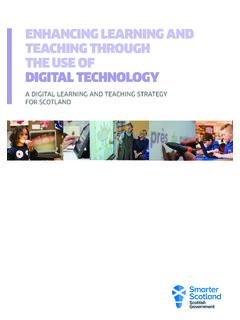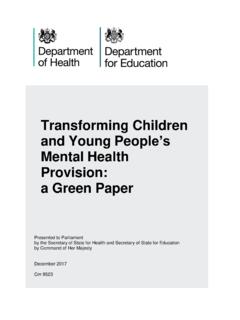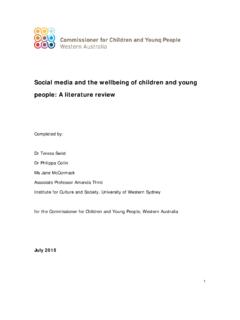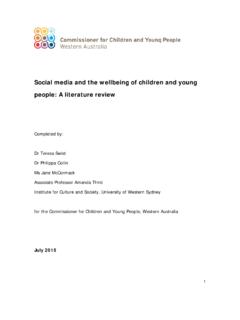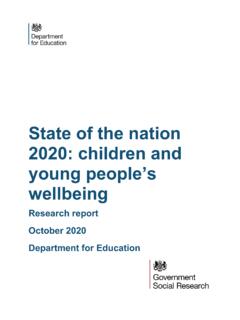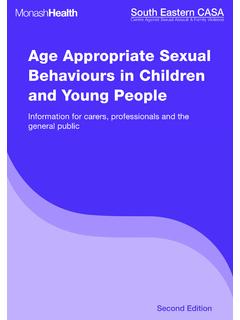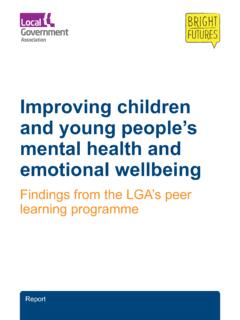Transcription of CHILDREN AND YOUNG PEOPLE (SCOTLAND) ACT 2014
1 CHILDREN AND YOUNG PEOPLE (SCOTLAND) ACT 2014:National Guidance on Part 12: Services in Relation to CHILDREN At Risk of Becoming Looked After, etc. Contents INTRODUCTION .. 1 DEFINITIONS .. 6 PART ONE: SERVICES IN RELATION TO CHILDREN AT RISK OF BECOMING LOOKED AFTER AND THE LEGAL FRAMEWORK .. 9 CHILDREN (Scotland) Act 1995 .. 9 Social Care (Self Directed Support) (Scotland) Act 2013 .. 10 Public Bodies (Joint working) (Scotland) Act 2014 .. 1 CHILDREN and YOUNG PEOPLE (Scotland) Act 2014 .. 2 Part 12 of the 2014 Act and the Relevant services in relation to CHILDREN at risk of becoming looked after etc. (Scotland) Order 2016 .. 4 PART TWO: SUPPORTING CHILDREN AND THEIR 6 Getting it Right for Every 6 Family Group Decision-Making Services .. 7 Support Services in Relation to Parenting .. 10 Publication of information about the provision of relevant services.
2 17 APPENDIX A: PART 12 OF THE 2014 ACT AND THE 2016 ORDER .. 18 APPENDIX B: FURTHER INFORMATION .. 22 1 INTRODUCTION 1. The Scottish Government, in collaboration with the Centre for Excellence for Looked after CHILDREN in Scotland (CELCIS), have developed this National Guidance to support the implementation of Part 12: Services in Relation To CHILDREN At Risk Of Becoming Looked After, etc. of the CHILDREN and YOUNG PEOPLE (Scotland) Act 2014 (the 2014 Act) and the Relevant services in relation to CHILDREN at risk of becoming looked after etc. (Scotland) Order 2016 (the 2016 Order). The 2014 Act defines relevant services and sets out the duties of local authorities to make arrangements to secure relevant services for eligible CHILDREN , qualifying persons and eligible pregnant women. Further descriptions of relevant services are specified in the 2016 Order.
3 2. This non-statutory guidance applies to those persons considered to be at risk of becoming looked after and the provision of relevant services as set out above. This guidance will not prescribe which services local authorities should offer as there are many different successful evidence based programmes available. Local authorities should consider which of their services will be most appropriate for the child s circumstances and ensure that appropriate other persons are included in the process. 3. We want Scotland to be the best place for all of our CHILDREN to grow up. Over the last ten years, the Scottish Government has developed Getting it Right for Every Child (GIRFEC), a national approach to improving the wellbeing of CHILDREN and YOUNG PEOPLE in Scotland. This builds on a growing body of evidence demonstrating the value of supporting CHILDREN and families at the earliest opportunity, rather than waiting until families reach crisis point.
4 This approach aims to achieve secure, nurturing, positive, childhoods, from which all CHILDREN and YOUNG PEOPLE can develop into successful learners, confident individuals, responsible citizens and effective contributors. This is underpinned by the Scottish Government s commitment to the United Nations Convention on the Rights of the Child (UNCRC) 1989. 2 4. The Scottish Government are committed to delivering public service reform as set out by the Christie Commission. The Commission proposed an asset-based approach, where services are developed with PEOPLE , rather than for PEOPLE . We recommend that, in developing new patterns of service provision, public service organisations should increasingly develop and adopt positive approaches which build services around PEOPLE and communities, their needs, aspirations, capacities and skills, and work to build up their autonomy and At the heart of the Christie Commission reforms are preventative approaches and early intervention to tackle inequalities across Scotland.
5 5. The services provided to families whose CHILDREN are at risk of becoming looked after (as per the duties set out under Part 12 of the 2014 Act) represent a critical component of that preventative approach, addressing issues at an earlier stage, and thereby preventing the need for more significant intervention in the child s life. As such, local authorities and their CHILDREN 's Services Planning Partners (including NHS Health Boards, Integrated Joint Boards, the Police, etc.) should consider setting out explicitly, within their local CHILDREN 's Services Plan, how they will engage and consult with families whose CHILDREN are at risk of becoming looked after, make available relevant services to meet their needs, and monitor those services effectiveness. The CHILDREN s Services Planning duties (Part 3 of the 2014 Act) are designed to facilitate this practice, encouraging and enabling local authorities and health boards to take a strategic approach to the design and delivery of all services used by CHILDREN and families.
6 6. Many CHILDREN and families can experience adversity in their lives. The US Adverse Childhood Experiences (ACE) study, involving 17,000 participants, revealed that two-thirds of adults experienced at least one adverse childhood experience. The study found that cumulative experience of adversity in childhood can increase the risk of poor outcomes in adulthood; for example, risky health 1 Christie Commission (2011) Report on the Future Delivery of Public Services by the commission chaired by Dr Campbell Christie, Public Services Commission (pg. 27). 3 behaviours, chronic health conditions, poor quality of life and early This work, alongside research on risk and resilience in childhood, has influenced our understanding on the importance of supporting CHILDREN and their families early to minimise adversity for the benefit of CHILDREN immediately and in the long term.
7 7. At times of difficulty, extended family and friends are often the main source of emotional and practical Practitioners supporting families have increasingly recognised that families have the ability to identify their own solutions to the challenges they face. This can increase self-esteem and self-efficacy within families. Fundamentally, in working with families, there is a shifting of power dynamics, and an increased recognition of the strengths and resilience within family networks and communities to overcome adversity. 8. Building on the assets within families and communities to prevent CHILDREN from becoming looked after is identified as a key principle in the Scottish Government s Getting it Right for Looked after CHILDREN and YOUNG PEOPLE Strategy (2015). We will improve outcomes for looked after CHILDREN through three priority areas of work: early engagement, early permanence and improving the quality of care.
8 The strategy also states the importance of providing high quality support and assessment for families. 9. As of July 2015, there were 15,404 CHILDREN and YOUNG PEOPLE who were looked after in Scotland; of these CHILDREN , three-quarters were looked after away from parents: in kinship care; with foster carers; in residential care; or in other community The primary reason for CHILDREN and YOUNG PEOPLE being looked after away from their parents is due to abuse and neglect. This guidance recognises that for some CHILDREN , becoming looked after away from home is essential to ensure they are safe and protected from significant harm. One-quarter of looked after CHILDREN are cared for by virtue of a supervision 2 Felitti VJ, Anda RF, Nordenberg D, Williamson DF, Spitz AM, Edwards V, Koss MP, Marks JS.
9 (1998) Relationship of childhood abuse and household dysfunction to many of the leading causes of death in adults: the adverse childhood experiences (ACE) study. American Journal of Preventative Medicine. 14(4): 245 258. 3 Bradshaw, P., Wasoff, F. & Jamieson, L (2008) Growing Up in Scotland: Use of Informal Support by Families with YOUNG CHILDREN , Edinburgh: Scottish Government. 4 Scottish Government (March 2016) CHILDREN s Social Work Statistics 2014-15, Edinburgh: Scottish Government. 4 requirement or a compulsory supervision order at home with birth parents or relevant persons. Research has identified that there has often been insufficient attention paid to the provision of support for CHILDREN who are looked after at 10. CHILDREN with complex disabilities may also be looked after CHILDREN due to the local authority and/or health board providing a care placement to meet the needs of the child.
10 At 31 July 2013, the last date for which national data was collected, there were 1,914 CHILDREN being looked after on a planned series of short-term placements. Sixty-one per cent of these CHILDREN were looked after in residential establishments, whilst 25 per cent were looked after in foster 11. Referrals to the Scottish CHILDREN s Reporter can provide an important insight into the reasons why CHILDREN may be at risk of becoming looked after. In 2014/15, 15,858 CHILDREN and YOUNG PEOPLE were referred to the Reporter; this equates to of all CHILDREN and YOUNG PEOPLE in Scotland. Almost 90% of referrals include care and protection grounds and the most common reasons for concern include; lack of parental care and domestic There has been a downward trend in referrals to the reporter since 2006 (after a sharp peak which was significantly due to a police policy of automatic referral where domestic abuse incidents had taken place).

